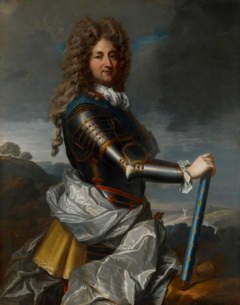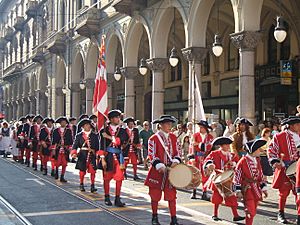Siege of Turin facts for kids
Quick facts for kids Siege of Turin |
|||||||
|---|---|---|---|---|---|---|---|
| Part of the War of the Spanish Succession | |||||||
 The Allied relief force breaks the French lines, lifting the siege of Turin |
|||||||
|
|||||||
| Belligerents | |||||||
| Commanders and leaders | |||||||
| Strength | |||||||
| Garrison; 15,000 Relief force; 30,000 |
60,000 total | ||||||
| Casualties and losses | |||||||
| Siege; 4,600 total (including disease) Relief operation; 3,500 - 4,800 killed and wounded |
Siege; 10,000 total (including disease) Relief operation; 7,000-9,000 |
||||||
The Siege of Turin was a major battle that happened in Turin, Italy, from June to September 1706. It was part of a bigger conflict called the War of the Spanish Succession. A large French army, led by Louis de la Feuillade, tried to capture Turin, which was the capital of the Savoyard state.
However, Prince Eugene of Savoy led a brave relief force that came to help Turin. His actions are often called one of the most brilliant military moves of the war in Italy. The siege is also remembered for the heroic death of Pietro Micca, a local soldier from Piedmont.
By 1706, France had taken control of most of the Duchy of Savoy. Only Turin remained under the control of its ruler, Victor Amadeus. The French began their attack on Turin on June 2nd, but they didn't make much progress. Meanwhile, Prince Eugene managed to outsmart the French army and join forces with Victor Amadeus.
Even though they had fewer soldiers overall, the combined forces attacked the French on September 7th. After tough fighting, they broke through the French lines. This forced the French to leave Northern Italy. Victor Amadeus got most of his lands back, but some areas north of the Alps stayed under French control until 1713.
Contents
Why Did the War Start?
The War of the Spanish Succession began in November 1700. This was after Charles II of Spain died without any children. He chose Philip of Anjou, who was the grandson of Louis XIV of France, to be his heir. Philip became king of the Spanish Empire on November 16th.
The Spanish Empire was huge. It included mainland Spain, parts of the Netherlands, large areas of Italy, and much of Central and South America. In 1701, arguments over land and trade rights led to war. France and Spain fought against the Grand Alliance. The Grand Alliance wanted Charles, the younger son of Leopold I, Holy Roman Emperor, to be king instead.
In Northern Italy, the fighting focused on the Spanish-controlled areas of Milan and Mantua. These areas were very important for protecting Austria's southern borders. In March 1701, French troops took over both cities. Victor Amadeus II, the Duke of Savoy, first joined with France. His daughter Maria Luisa even married Philip V.
But in October 1703, Victor Amadeus decided to switch sides. He joined the Grand Alliance instead. During 1704, French armies led by de la Feuillade captured Savoyard lands north of the Alps. These included Villefranche and the County of Savoy. By the end of 1705, Turin was the only important city still controlled by Savoy.
The Siege Begins
On May 12th, 1706, about 48,000 French soldiers arrived outside Turin. They were led by de la Feuillade. However, they didn't fully surround the city until June 19th.
The French commander, Louis Joseph, Duke of Vendôme, was called back to France in July. This was after a big French defeat at Ramillies in Flanders on May 23rd. Philippe II, Duke of Orléans, who was less experienced, took over command in Italy. He had Ferdinand de Marsin as his main advisor.
Turin's defenses had two main parts. There was the outer city, where people lived and worked. At its center was a strong Citadel. Usually, attackers would capture the city first. This would let them bomb the citadel from up close. But La Feuillade decided to start firing at the citadel right away. He set up his guns 300 meters outside the city.
The citadel had been greatly improved since 1696. It was based on designs by the French engineer Vauban. Much of it was underground, including 15 kilometers (9.3 miles) of tunnels. These tunnels were used to fight against enemy sapping (digging tunnels). Vauban had warned that firing from far away would only hit the top parts of the walls, not the base.
Heroic Defense

On June 17th, Victor Amadeus left the city with 7,000 cavalry. He left the Austrian general Philipp von Daun in charge of Turin's defense. Victor Amadeus spent the next two months attacking French supply lines. He hoped to buy time for Prince Eugene to arrive.
La Feuillade kept up the siege, but he didn't have much success. As Vauban had predicted, the bombing caused a lot of damage, but the citadel remained mostly intact. French attempts at mining under the city also failed.
On August 15th, Prince Eugene began his march towards Turin. He easily avoided Orléans's forces. On August 29th, he reached Carmagnola, south of Turin. There, he was joined by Victor Amadeus. This march was a great achievement. Prince Eugene took an army that had been beaten and reorganized it. Then, he marched 200 miles in 24 days. He crossed four major rivers and broke through enemy lines.
Orléans knew Prince Eugene was coming. He joined La Feuillade, and their combined forces launched three attacks on Turin between August 27th and September 3rd. All of these attacks were pushed back with heavy losses for the French.
Pietro Micca was killed on August 31st. He blew up a mine to stop the French from breaking into one of the tunnels under the citadel. This act saved the city. Including deaths from disease, which was common during long sieges, the French lost 10,000 soldiers. The defenders lost 4,500.
The Battle for Turin

Even after their losses, the French army around Turin still had more soldiers than the combined Imperial-Savoyard relief force. The relief force had about 30,000 soldiers. However, the French were spread out along 25 kilometers (15.5 miles) of defenses. Their morale was low after the failed attacks.
On September 5th, the Savoyard-Imperial army gathered at Collegno. This was near a weak spot in the French lines. On September 7th, Prince Eugene divided his army into eight columns. Each column had two lines, with gaps for their artillery.
The battle started with an exchange of artillery fire. But the Imperial guns didn't do much damage to the French defenses. Around 11:00 am, Prince Eugene ordered a full attack. Although Charles of Württemberg broke through on the left, the rest of the army was held back. But repeated attacks by Leopold, helped by a charge from von Daun, finally forced the French to retreat.
Orléans was wounded, and Marsin was also wounded, captured, and died the next day. French losses were between 7,000 and 9,000 soldiers, including many prisoners. The Allies lost between 3,500 and 4,800 soldiers. The French left Turin, abandoning their siege cannons, and retreated towards Pinerolo. Victor Amadeus returned to his capital the same day.
What Happened Next?
On September 8th, a French group in Lombardy won a small battle. But this didn't change the overall situation. French soldiers left their forts in Pinerolo and Susa, and Savoy took them back. In 1708, Victor Amadeus gained the small Duchy of Montferrat. However, Nice and the County of Savoy were not returned by France until 1713.
In March 1707, Emperor Joseph signed an agreement with France called the Convention of Milan. This ended the war in Northern Italy. In exchange for giving Milan and Mantua to Austria, French and Spanish troops were sent home with all their equipment. Many of these soldiers went to Southern France. They helped defeat an Allied attack on the French naval base at Toulon in July. In April, Joseph captured the Spanish-ruled Kingdom of Naples. This made Austria the strongest power in Italy for the first time in 200 years.
After Italian unification in the 1800s, Pietro Micca became a symbol of Italian patriotism. He was the hero of a 1938 film called Pietro Micca. In 2006, many studies were published to mark 300 years since his death.
In 2004, workers building an underground parking lot in the Piazza Vittorio Veneto found 22 skeletons. These skeletons were from the early 1700s. A study in 2019 showed that these were almost certainly soldiers who died during the 1706 siege.
Sources
See also
 In Spanish: Sitio de Turín (1706) para niños
In Spanish: Sitio de Turín (1706) para niños


